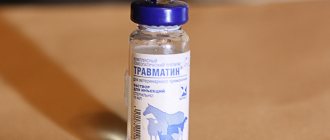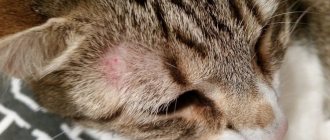What a pet owner needs to know about catheters
Placing a catheter is more difficult than simply injecting the drug into a vein. It happens that not every veterinarian succeeds in placing the catheter correctly the first time. Therefore, before you start using it, you need to know a few rules:
- The catheter requires careful care: after each use it must be thoroughly rinsed and dried.
- If the catheter is placed for a long time, you need to make sure that the animal does not start licking it: it can come off. During injections using a catheter, you need to be close to your pet and make sure that the catheter is positioned correctly at all times.
- When any drug is administered into a vein, there may be a risk of various bacteria and fungi entering the blood. To prevent this from happening, you need to thoroughly disinfect the injection site and ensure that the catheter is sterile.
- To prevent the animal from unwittingly removing the catheter, you can bandage it with a bandage for greater confidence - this will make it much more difficult to remove the device.
Before installing a catheter, several conditions must be met:
- Place a clean sheet or diaper on a flat surface where it would be most convenient for you to place the catheter in your pet.
- Place your pet on the sheet. It is necessary that he behave calmly and reservedly.
- The fur on the area where the catheter is to be placed must be shaved, so this issue must be addressed in advance before inserting the catheter.
- Most often, the catheter is placed in the paw. During insertion of the catheter, it should be straight and motionless. To fix it, it is best to use a splint - a special board usually used to heal broken limbs.
- The place where the catheter will be inserted must be disinfected with an alcohol solution.
You need to install a catheter in your pet as follows:
- Provide maximum illumination in the room.
- Wash and dry your hands and put on sterile gloves.
- Apply a tourniquet 10-15 cm above the catheterization site.
- Select a vein to insert the catheter into. Considering the size of the selected vein, select the appropriate catheter size.
- Treat the catheterization site with an antiseptic.
- Remove the protective cover from the catheter and insert the catheter at an angle of 15 degrees. Once blood appears in the catheter stylet, reduce the angle of inclination and continue inserting the catheter.
- Fix the needle and slide the cannula into the vein to the end; There is no need to remove the needle from the catheter yet.
- Remove the tourniquet.
- Clamp the vein and remove the needle from the catheter.
- Discard the needle.
- Secure the catheter by placing an adhesive tape over the catheterization site.
How to remove a catheter
When using a catheter, unusual situations may arise: for example, a dog chewed the catheter, or it was installed incorrectly, or the pet's paw became swollen - in these and many other cases, it is necessary to quickly remove the catheter. How to do it?
To remove an intravenous catheter, it is enough to cut the plaster with which the catheter was fixed to the pet’s limb, and then carefully peel the catheter off the paw, pulling the plastic tube out of the vein. Apply a swab moistened with alcohol to the catheterization site and bandage the limb. After an hour, remove the bandage - the catheter removal procedure is completed.
To remove an intravenous catheter, it is enough to cut the plaster with which the catheter was fixed to the pet’s limb, and then carefully peel the catheter off the paw, pulling the plastic tube out of the vein.
The cat owner has to carry out this procedure 5 days after installation, in case of mechanical damage to the catheter, or if the pet’s limb with branula is swollen.
The catheter is usually located on the cat's front legs. It is fixed with the turn of a regular adhesive plaster. In order to remove the intravenous catheter from the cat, it is enough to cut this dressing from bottom to top. Then the remaining patch must be carefully removed from the pet's hair.
- When the device is pulled out, the animal may try to escape. Therefore, removing a cat’s catheter at home is much easier with two people;
- when pulling out the tube, the movement should be careful, but as fast as possible;
- instead of alcohol, you can use a solution of furatsilin or hydrogen peroxide to wet the disinfectant swab;
- If suspicious symptoms appear after removing the catheter, it is better to seek help from a veterinarian. Such uncharacteristic signs when removing the device include: swelling of the extremities, discoloration of the skin, lameness or clenching of the paw, pain on palpation, development of hyperthermia, lack of appetite, weak and apathetic state;
- It is best to use nail scissors to cut the patch, as they will remove the bandage more accurately. If the animal twitches, then it is better to give preference to a device with rounded ends.
We have a difficult task - we need to give an intravenous injection to a dog!
When using a catheter, unusual situations may arise: for example, a dog chewed the catheter, or it was installed incorrectly, or the pet's paw became swollen - in these and many other cases, it is necessary to quickly remove the catheter. How to do it?
To remove an intravenous catheter, it is enough to cut the plaster with which the catheter was fixed to the pet’s limb, and then carefully peel the catheter off the paw, pulling the plastic tube out of the vein. Apply a swab moistened with alcohol to the catheterization site and bandage the limb. After an hour, remove the bandage - the catheter removal procedure is completed.
To remove an intravenous catheter, it is enough to cut the plaster with which the catheter was fixed to the pet’s limb, and then carefully peel the catheter off the paw, pulling the plastic tube out of the vein.
Sometimes situations arise when a cat is inserted into a catheter. Moreover, it can be inserted into almost any part of the body. Typically, the catheter is inserted for a few days and then removed. In most cases, the catheter is removed by a doctor, but sometimes, for some reason, it is not possible to see a doctor to remove it.
First of all, it is still necessary to remember that removing the catheter yourself is possible only in the most extreme cases. It must also be removed exactly on the day indicated by the doctor, no earlier, no later. The procedure should be carried out very carefully and slowly. All instruments that will be used during this procedure must be clean and sterile. To remove the catheter you will need tweezers and small nail scissors.
It is necessary to very carefully and slowly cut the threads that hold the catheter in one position. In this case, they must be cut very carefully and only on one side. Once the cut is made, the threads are carefully pulled out from the animal's skin using tweezers. At the same time, you need to make sure that even the smallest piece of these threads does not remain in the skin.
After the threads are removed, it is necessary to carefully, but at the same time quickly remove the catheter itself. At the same time, during this procedure we must not forget that the catheter for cats, although it does not cause them pain, still causes some inconvenience. Therefore, the animal may try to run away during removal, which means that two people need to remove the catheter.
After the catheter is removed, the place where it was inserted must be disinfected. As a disinfectant solution, you can use a pharmaceutical solution of furatsilin or hydrogen peroxide.
If the owner of the animal knows in advance that the catheter will have to be removed on his own, it is necessary to immediately clarify at a doctor’s appointment how exactly and with what preparation will need to be disinfected, if any is needed at all. It is also best to immediately consult with your doctor about exactly how to remove the catheter.
The cat owner has to carry out this procedure 5 days after installation, in case of mechanical damage to the catheter, or if the pet’s limb with branula is swollen.
shutterstock
The catheter is usually located on the cat's front legs. It is fixed with the turn of a regular adhesive plaster. In order to remove the intravenous catheter from the cat, it is enough to cut this dressing from bottom to top. Then the remaining patch must be carefully removed from the pet's hair. After this manipulation, you can remove the catheters from the cat’s paws by pulling out the plastic tube from the vein. Apply a thick bandage soaked in alcohol to the previous location of the scold, and bandage the paw for the next hour.
- When the device is pulled out, the animal may try to escape. Therefore, removing a cat’s catheter at home is much easier with two people;
- when pulling out the tube, the movement should be careful, but as fast as possible;
- instead of alcohol, you can use a solution of furatsilin or hydrogen peroxide to wet the disinfectant swab;
- If suspicious symptoms appear after removing the catheter, it is better to seek help from a veterinarian. Such uncharacteristic signs when removing the device include: swelling of the extremities, discoloration of the skin, lameness or clenching of the paw, pain on palpation, development of hyperthermia, lack of appetite, weak and apathetic state;
- It is best to use nail scissors to cut the patch, as they will remove the bandage more accurately. If the animal twitches, then it is better to give preference to a device with rounded ends.
More details
Even if your pet is absolutely healthy, carrying out such activities as deworming and vaccination requires the owners to have some veterinary skills.
It should be noted that medications can be given to a dog only as prescribed by a veterinarian, based on examinations and a clinical diagnosis. Otherwise, you can not only harm the health of the animal, but even endanger its life.
How to give your dog tablets, pills, capsules?
The medicine can be given to the dog by first mixing it with food. However, you should consult your veterinarian whether it is compatible with any type of food.
If you need to feed a tablet (dragee, capsule) in its pure form, the dog needs to open its mouth and quickly place the tablet on the root of the tongue. These dosage forms can be pre-moistened with sterile petroleum jelly to prevent the medicine from sticking to the tongue and lips. After this, the mouth should be closed and, holding the dog’s head in a horizontal position and the jaws clenched, stroke the animal’s neck towards the esophagus - this facilitates the process of swallowing the medicine.
How to give your dog oral fluids?
Liquid medications should be given to your dog using a syringe without a needle.
To do this, lift the animal’s head and pull the edge of the lip in the corner of the mouth with your finger. There is an edentulous space between the canine and first and second premolars. The tip of the syringe should be inserted into this space and, pressing lightly on the piston, the drug should be injected. As with pills, the animal's neck should be stroked toward the esophagus to encourage swallowing of the medication. It should be noted that liquid medications are given in portions per sip, which averages 5 ml.
How to give a dog injections?
More details
Nowadays there is a lot of debate about keeping fighting dogs. In some countries they are banned. But the most patient and kind dog that I came across in practice turned out to be precisely from this category. It was a huge American Staffordshire Terrier for its breed. He had just recovered from parvovirus enteritis (owners who have encountered this disease know how serious it is), but overall he was recovering and was no longer so weakened.
But his veins were terrible: collapsed, all punctured, there was simply no living space, and I was an inexperienced trainee. I needed to put him on a drip and insert a needle into a vein, but it didn’t work. I literally had to pick at the dog’s paws. Those who were once sick for a long time know how painful it is when they insert a needle into a vein to draw blood or inject medicine, and it is already quite punctured.
But he was silent, only his huge muzzle hung menacingly over my head. The owner and my boss said that he didn’t even need to be tied up, I had to believe them, but my heart was beating wildly. One paw, the second, the first again...no way. I was just about to call someone more experienced when I finally got it. And then a long, heartbreaking sigh was heard above my head...
Intravenous catheter assembled.
Back then we very rarely used intravenous catheters: it was expensive for owners and troublesome for veterinarians. But now they are gaining popularity in veterinary clinics. Their most important advantage: you don’t have to abuse animals like I did!
Like virtually any veterinary procedure, placing an intravenous catheter has its advantages and disadvantages. Let's talk about them.
A catheter is an especially good help for a veterinarian when the animal suffers from a serious illness that requires constant intravenous administration of drugs. After all, punctured veins are not only painful for the animal, but can also lead to thrombophlebitis, which is completely undesirable for him at such a moment.
More details
Then come in and we will definitely help!
Attention! Due to a large number of requests, we have moved to a new VIP server
If the site takes a long time to load,
follow THIS link
The need to put a drip on a cat or dog can arise from such animal ailments as kidney failure, vomiting, acute poisoning, diarrhea, after surgery, severe dehydration... That is why any owner of a four-legged animal should be able to put a drip on their pet at home.
Basic Rules
Before you put an IV on your cat or dog, you can watch how the doctor does it. Today, most veterinarians use a catheter or branula for IVs. It is needed so as not to pierce the animal’s skin every day. Then you can put a drip subcutaneously at home. The main thing is to follow a few important rules.
- Rule one. Any solution you give your dog or cat subcutaneously or intravenously should be warm or at room temperature. If medicine is administered subcutaneously to an animal that is too cold, it may cause trembling or a drop in temperature;
Advice: If the pet’s body temperature has dropped too much, it is recommended to lower the plastic tube through which the medicine is delivered into water (temperature about 80 degrees) and heat the solution.
- Second rule. We administer the medicine slowly. Slowly - this is one drop per second or two. Otherwise, trembling, a drop in temperature, vomiting and an increase in blood pressure are also possible;
- Rule three. Air should not be allowed into the vein of a cat or dog, otherwise a gas embolism may occur. Some people are afraid to put IVs on animals themselves because of this. But if you follow all the instructions, nothing bad will happen. But even if one small bubble of oxygen gets into a vein, it’s not so scary;
- One more rule. A cat or dog should not be left alone during an IV drip. Even the most obedient animal can run away if you lose control over it.
- Don't be afraid to put in an IV. This is important, because the animal will definitely feel fear. Act calmly and confidently.
How to insert or remove a catheter for a dog or cat at home?
How to insert or remove a catheter for a dog or cat at home?
Everyone's favorite dogs and cats constantly delight us with their grace and beauty. However, they sometimes get very sick, for example, with severe poisoning and diarrhea.
If they are not given immediate help, they will die. And we, ordinary people, lack the skills and abilities to provide the necessary assistance.
Many diseases require serious attention that there is a need to give IVs, but it is not possible to visit a doctor.
But if you prick a dog or cat every day, then there will be no living space left on them. Therefore, an intravenous catheter becomes a great help, with the help of which you can make both a drip and an injection at any time.
Advantages of a catheter for placement in dogs and cats
A catheter is an especially good help for a veterinarian when the animal suffers from a serious illness that requires constant intravenous administration of drugs. After all, punctured veins are not only painful for the animal, but can also lead to thrombophlebitis, which is completely undesirable for him at such a moment.
In addition, placing a catheter is simply necessary when your four-legged friend needs round-the-clock care. There are diseases, for example, parvovirus enteritis, feline panleukopenia, piroplasmosis, severe poisoning and others, in which it is necessary to install IVs not only during the day, but also during the night.
Drip administration of medicinal substances is not recommended for owners to do on their own.
The safest substance, ordinary saline, when administered intravenously in large quantities, can cause many problems: the volume of the liquid part of the blood increases sharply, and it becomes difficult for the heart and kidneys to cope with it. Therefore, the most basic dropper should be under the supervision of a veterinary specialist.
But in rare cases, when the owner for some reason cannot bring the animal or call a doctor at home, an IV can be placed at home. In such cases, it is simply great if the clinic has previously installed an intravenous catheter for his pet.
Disadvantages of catheter placement in dogs and cats
Catheters also have disadvantages. One of the main ones is that placing a catheter is more difficult than simply injecting a drug into a vein. This requires certain skills and not every veterinarian manages to introduce it the first time. In addition, the catheter requires very careful care.
Any intravenous administration of drugs is dangerous because bacteria and fungi can enter the blood and cause sepsis.
This can happen if the injection site is not sufficiently disinfected, with catheters in the vein for a long time (therefore, the catheter is placed for 3-5 days, after which it is removed, if it is necessary to continue intravenous infusions, then a new catheter is placed on the other leg), with poor care catheter. If the first lies on the conscience of the veterinarian, the second is almost excluded (animals are rarely given intravenous catheters for a long time), then the last is the work of the owners.
It is important to ensure that the animal does not lick the catheter, the bandages do not get wet and are changed regularly, and the skin remains clean. It should be noted that animals do not like catheters.
Not that it hurts, but let's face it, not everyone likes having some kind of plastic thing sticking out of your paw. They often chew the bandage and pull out the device that is interfering with them.
But still, all the advantages of intravenous catheters outweigh the disadvantages.
When should an intravenous catheter be used in dogs and cats?
- Emergency conditions, resuscitation, operations that require quick access to the bloodstream (for example, if you need to administer drugs urgently and at high speed).
- Hospitalization of an animal with seizures.
- Prescribed parenteral nutrition.
- Overhydration or hydration of the body.
- Transfusion of blood products (whole blood, packed red blood cells).
- Repeated or continuous administration of drugs intravenously.
- The need for rapid and accurate administration of the drug in an effective concentration (especially when the drug can change its properties when taken orally).
Well-chosen venous access largely ensures the success of intravenous therapy.
Criteria for choosing a vein and catheter for dogs and cats
Theoretically, the catheter can be inserted into any superficial vein. The most commonly used veins are the cephalic (saphenous) vein, the medial and lateral saphenous vein. Central venous access can be obtained through the jugular vein and saphenous vein.
The lateral saphen vein is more accessible in dogs, whereas in cats it is easier to insert a central catheter through the medial saphen vein. Catheters inserted into the hind leg are more difficult to keep clean and are not recommended for patients with urinary incontinence or diarrhea.
With intravenous injections, the advantage remains with the peripheral veins. The veins should be soft and elastic, without compactions or knots. It is better to inject drugs into large veins, in a straight section corresponding to the length of the catheter.
When choosing a catheter, you must focus on the following criteria:
- Vein diameter (the diameter of the catheter must be less than the diameter of the vein).
- Required speed of solution administration (the larger the catheter size, the higher the solution injection rate).
- Potential time the catheter remains in the vein (no more than 3 days).
When catheterizing veins, preference should be given to modern Teflon and polyurethane catheters. Their use significantly reduces the frequency of complications and with high-quality care, their service life is much longer.
The most common cause of failure and complications during catheterization of peripheral veins is the lack of practical skills of the catheter inserter, violation of the technique for placing a venous catheter and caring for it.
This is largely due to the lack of generally accepted standards for peripheral venous catheterization and catheter care in veterinary medicine.
What does a catheter consist of?
- 1. Valve for introducing substances, for example, heparin solution. In the photo it is blue, but it can be green, pink, gray or other - the different colors help determine the size of the device.
- 2. Part of the stylet that is removed after installation.
- 3. A cap is screwed onto the cannula to close the entrance to the vein.
- 4. Cannula – here you need to connect a system or a syringe without a needle.
Preparing dogs and cats for peripheral catheter placement
- Lay out a clean diaper or sheet (it is ideal if you iron or steam it with an iron).
- Lay down and calm your pet.
- Shave the fur where you are going to place the IV.
- It's better if it's a paw. In any case, the location will be determined by the veterinarian.
- The animal's paw should be straightened so that the vein is not pinched. You can fix it (the paw) with a splint - a board bandaged to the paw.
- The puncture site is disinfected.
Elements required for peripheral venous catheterization in dogs and cats
A standard peripheral vein catheterization kit includes:
- Sterile tray.
- Sterile beads moistened with disinfectant solution.
- Sterile “pants”.
- Band-Aid.
- Peripheral intravenous catheters in several sizes.
- Tourniquet.
- Sterile gloves.
- Scissors.
- The bandage is medium.
Rules for placing a peripheral catheter in dogs and cats
- Placement of the catheter must begin by ensuring good lighting of the manipulation site.
- Next, hands are thoroughly washed and dried.
- A standard set for vein catheterization is assembled, and the set should contain several catheters of different diameters.
- Apply a tourniquet 10-15 cm above the intended catheterization area.
- A vein is selected by palpation.
- A catheter of the optimal size is selected, taking into account the size of the vein, the required insertion speed, and the schedule of intravenous therapy.
- Re-treat your hands using an antiseptic and put on gloves.
- The catheterization site is treated with a skin antiseptic for 30-60 s and allowed to dry.
- The vein should not be palpated repeatedly! Fixing the vein (it is pressed with a finger below the intended site of catheter insertion).
- Take a catheter of the selected diameter and remove the protective cover from it. If there is an additional plug on the cover, the cover is not thrown away, but held between the fingers of your free hand.
- The catheter is inserted on the needle at an angle of 15° to the skin, observing the indicator chamber. When blood appears in it, reduce the angle of the stiletto needle and insert the needle into the vein a few millimeters.
- Having fixed the stiletto needle, slowly move the cannula completely from the needle into the vein (the stiletto needle is not yet completely removed from the catheter).
- Remove the tourniquet.
- Do not insert a needle into the catheter after it has been dislodged from the needle into the vein! The vein is clamped to reduce bleeding, and the needle is finally removed from the catheter.
- The needle is disposed of taking into account safety rules.
- Remove the plug from the protective cover and close the catheter or connect the infusion system.
- The catheter is fixed on the limb.
Rules for caring for catheters installed in dogs and cats
Each catheter connection is a gateway for infection. Repeated touching of the instruments with your hands should be avoided. It is recommended to change sterile plugs more often and never use plugs whose inner surface could be infected.
Immediately after the administration of antibiotics, concentrated glucose solutions, and blood products, the catheter is washed with a small amount of saline. To prevent thrombosis and prolong the life of the catheter in the vein, it is recommended to rinse the catheter with saline solution additionally - during the day, between infusions.
Complications after venous catheterization are divided into:
It is necessary to monitor the condition of the fixing bandage and change it if necessary, as well as regularly inspect the puncture site in order to identify complications as early as possible.
If swelling, redness, a local increase in temperature, obstruction of the catheter, leakage, or pain in the animal to which the drug is administered occurs, it is necessary to remove the catheter and seek help from a veterinarian.
When changing an adhesive bandage, do not use scissors, because the catheter can be cut off, causing it to enter the bloodstream. It is recommended to change the catheterization site every 48-72 hours. To remove a venous catheter, you need a tray, a ball moistened with a disinfectant solution, a bandage, and scissors.
Despite the fact that catheterization of peripheral veins is a much less dangerous procedure than catheterization of central veins, if the rules are not followed, it can cause a complex of complications, like any procedure that violates the integrity of the skin. Most complications can be avoided with good manipulation technique, strict adherence to the rules of asepsis and antisepsis, and proper care of the catheter.
How to remove an intravenous catheter from a dog or cat?
Another common medical procedure that the owner can handle independently is the removal of an intravenous catheter (branula). This manipulation is not complicated and may be required for a number of reasons.
Firstly, if the branula remains in the vein for more than 5 days, secondly, if your pet’s paw in which the branula is placed is swollen below the catheter installation site, and thirdly, if the dog or cat almost chewed the catheter on its own .
It should be noted that intravenous catheters are usually placed in peripheral veins located on the extremities of animals. Catheters are fixed to the skin and fur by applying several rounds (turns) of adhesive tape.
To remove an intravenous catheter, simply cut the adhesive tape perpendicular to the applied tours, then slowly peel it away from the fur and pull the plastic tube out of the vein. At the site where the branula enters the vein, tightly apply a swab moistened with alcohol and bandage the paw tightly for an hour.
During this technically simple procedure, you should remember that the adhesive plaster should be cut only perpendicular to the tours, but not parallel to them.
Main indications for catheter placement
Basic Rules
Bladder catheterization sometimes becomes the only possible way to remove urine and save the animal’s life.
Urolithiasis in cats is the process of stone formation in the bladder and urethra. Clinically, when the disease occurs, urinary retention or urine leakage in droplets, and the appearance of blood in the urine are observed. The cat may sit in the litter box for a long time and try to urinate to no avail. In addition, the primary symptom of the disease is frequent, prolonged, painful urination. Urine is discolored and smells unpleasant. The cat has to undergo bladder catheterization to save his life.
Urolithiasis can be fatal. For example, if a cat fails to defecate within several days, the lethal end #8212; inevitable. To save the animal, urine should be drained in time using a catheter. For veterinarians, the problem of urolithiasis in cats is a daily occurrence. In this area, our specialists have extensive experience in catheterization and treatment of the disease. They can save even the most hopeless purr.
Treatment of urolithiasis in animals at home is carried out by professional veterinarians. You should check with your doctor over the phone about the cost of treatment. Unfortunately, without medical help you will not be able to help your pet.
- The therapeutic process begins with manual massage of the cat's bladder. This manipulation helps remove sand plugs. If urine does not pass on its own, there is a need for urgent catheter placement. Veterinarians perform this procedure with brilliant success, eliminating any complications. Bladder catheterization is a simple procedure, but the owner should not do it himself.
- Catheterization is performed at home under general anesthesia. You can put a catheter on a cat without anesthesia if there are contraindications: the animal is over 10 years old or is severely weakened. After the procedure, symptomatic treatment is prescribed using anti-inflammatory drugs, anesthetics, antispasmodics, homeopathic drugs, antibacterial, physiotherapeutic agents, and vitamins.
- Doctors may prescribe medications that help dissolve stones inside the bladder. While you are undergoing treatment, you will have to periodically catheterize your bladder.
- But one of the most important components, which is mandatory in the process of treatment and further prevention of urolithiasis in cats, is maintaining a proper diet. Mixtures of special feeds help speed up the treatment process.
- For drug treatment, intramuscular solutions of no-shpa and antispasmodic are used. In case of blockage of the urethra, a 0.5% solution of novocaine is administered through a catheter.
- Pain syndrome is eliminated using novocaine blockade with a 0.25% solution. Intramuscular administration of bicillin-3 helps relieve inflammation of the urinary tract.
- In addition, decoctions of corn silk, bearberry leaves, and biseptol can be used.
Catheter for urine excretion.
Symptoms of the disease in cats depend on the duration of urinary retention. A constant urge to urinate in an animal is considered a clear sign of urolithiasis. Observing the animal, you can notice how alarmed and exhausted it is, meows in pain during defecation, and then licks its genitals.
Palpation of the bladder allows you to determine that the organ is greatly distended. With prolonged urinary retention (more than 2 days), the bladder can rupture, causing the development of peritonitis and subsequent death of the animal. Therefore, catheterization of the cat’s bladder in such cases is extremely necessary!
In order to empty a full bladder, it is necessary to insert a catheter into the cat. This procedure is the only condition for saving the life of the pet. Owners should know that every fifth cat dies from untimely assistance for the formation of stones in the excretory system.
Catheterization for conservative treatment of urolithiasis
Catheterization is performed in the following situations:
- with conservative treatment of urolithiasis;
- urinary disorders of various etiologies;
- surgical intervention (for urine output during and after surgery);
- when therapeutic procedures are carried out (washing the urethra, bladder);
- to control urination, collect urine;
- for X-ray diagnostics using a contrast agent.
Catheters can be installed for a short period of time, for example, during a diagnostic examination, for collecting tests, or for a one-time excretion of urine. For these purposes, polypropylene models are most often used. The answer to the question of how long a cat’s catheter should last will depend on the severity of the animal’s disease and the characteristics of the pathology.
They often resort to permanent urethral catheters, for example, when the animal is in serious condition, with acute renal failure, or with bladder injuries. For permanent catheterization, models made of polyvinyl chloride are used, which are less traumatic for the animal compared to polypropylene.
Catheterization is a purely medical procedure that requires certain knowledge and skills. Therefore, it can only be carried out by qualified personnel. The owner must have an idea of how to place a catheter in a cat in order to understand the seriousness of subsequent care for the pet.
Catheterization also has contraindications. Manipulation cannot be carried out when:
- acute infectious diseases,
- damage to the urethra and bladder by tumors.
An animal may require catheterization not only due to urolithiasis, but also for a number of other indications. A cat is subject to bladder catheterization in the following cases:
- a conservative method of treating urolitasis - a urinary catheter is used, depending on the condition of the animal, once or continuously;
- traumatic injuries of the bladder;
- disturbances in the passage of urine in acute form due to any disorder when catheterization is required for emergency emptying of the organ, even before the cause of the phenomenon is determined;
- surgical interventions in which a catheter is inserted so that urine can easily pass both during the operation itself and after it, when the functioning of the bladder muscles may be impaired due to anesthesia;
- therapeutic lavage of the bladder and urethra, which is carried out so that medicinal substances can be delivered to the sore spot;
- determination of the volume of urination and the need to collect urine when catheterization is carried out for a short period of time, and after obtaining the material necessary for the study, the catheter is removed;
- X-ray of the bladder with contrast, in which catheterization is required to administer the contrast agent.
shutterstock
For one-time use for a short time, cheaper catheters made of polypropylene are used. If the presence of a catheter in the cat’s body is required for more than one day, then a device made of polyvinyl chloride is used, which is more comfortable for the animal and does not cause significant negative sensations. After catheterization, the cat must be completely isolated from the street to prevent bladder infection.
The main indication for installing a catheter is urolithiasis in a cat, in which there is impaired insufficient urine flow. This violation can be noticed by several signs.
- Small puddles outside the tray to the whole house. This happens due to the fact that the cat cannot suppress the acute urge to urinate, but due to impaired discharge, physiological fluid is released in excessively small quantities.
- The pet often goes to the litter tray. In this case, the cat sits for a long time in a position corresponding to the one it takes when urinating, but there is no urine output at all.
- A loud cry at a time when, in addition to physiological fluid, which is small, a significant amount of blood is also drained.
- A serious increase in the size of the bladder, which can be easily felt when palpating the abdomen even by a non-specialist. The manipulation must be carried out extremely carefully so that the maximally stretched walls of the overcrowded organ do not rupture.
If symptoms of urinary retention occur, after examining the animal, the veterinarian will determine whether bladder catheterization is necessary or not. If the cat is able to clear urine from the bladder, albeit incompletely, treatment without the use of a catheter can be done.
Before removing the catheter from a cat, you should check for kinks and distortions in the system, otherwise injury to the mucous membrane of the urinary tract is possible. Only a veterinarian should remove the catheter.
After the catheterization procedure, the animal is usually prescribed antispasmodic drugs to facilitate the process of urination. To prevent the development of a bacterial infection, antibacterial agents are prescribed. Since obstruction of the urinary tract is often a consequence of the disease, after the elimination of ischuria, treatment of the underlying pathology continues.
Owners often encounter various problems when catheterizing an animal. For example, a cat cannot pee after a catheter. This phenomenon is observed due to spasm of the urethral muscles. In this case, the animal is prescribed antispasmodic drugs. For this purpose, no-shpa, spazgan, and papaverine are used. Manual bladder massage is also effective.
If a cat pulls out a catheter, what should the owner do in such a situation? The animal, regardless of the reasons for which catheterization was performed, must be immediately taken to a veterinary institution.
If your pet has urological syndromes that indicate difficulty urinating, then catheterization is sometimes the only solution in this situation. Only a veterinarian should insert and remove a catheter. Independent manipulations are unacceptable, as they involve the risk of injury and rupture of the urethra and bladder.
Bladder catheterization in a cat: technique and consequences
Cat and Cat > Health > Bladder catheterization in a cat: technique and consequences
Bladder catheterization in cats is a common procedure performed by veterinarians to diagnose and treat diseases of the genitourinary system in this species of animal. Manipulation is more often performed on males than females, as females are anatomically less likely to have obstruction than females.
What is this
Bladder catheterization is one of the methods for treating urolithiasis in cats, various forms of cystitis of different etiologies and other pathological conditions of the bladder. The event is carried out strictly by veterinary specialists, since a person without proper anatomical knowledge can cause severe injury to the urethra and penis.
With the help of bladder catheterization, you can alleviate the animal’s condition, administer the necessary medications directly into the organ, and also take urine tests for laboratory testing to determine if there are any changes in the functioning of the internal organs.
Bladder catheterization performed within the clinic is harmless to the animal, since only experienced specialists are allowed to perform the procedure.
Indications and contraindications
The main indications for bladder catheterization in cats:
- Various obstructions of the urinary canal.
- Urolithiasis disease.
- Idiopathic cystitis.
- Inflammation of the urethra.
- Collection of urine analysis.
- Surgeries on the bladder, when a permanent absence of urine in the organ is necessary
- Functional disorders, when the animal cannot urinate on its own (paralysis)
The main contraindications for bladder catheterization in cats:
- Decreased immunity in the presence of various viral diseases.
- Tumors of the bladder and urethra.
- Sepsis.
Preparation
- Conducting research on the presence of indications and contraindications for bladder catheterization . If catheterization is impossible, the animal is prescribed alternative methods for removing urine from the organ.
- Animal anesthesia. This is necessary so that the animal does not feel pain during all manipulations.
Without sedation, the cat can harm itself and the veterinarian. General anesthesia or regular sedation is used. The first option applies to animals whose condition is satisfactory, without severe intoxication and the absence of pathologies from the cardiovascular system.The second option is acceptable for animals with a prolonged course of the disease, accompanied by intoxication, lack of appetite and other functional disorders. Catheterization of the bladder without prior anesthesia is applicable to animals in serious condition.
- Genital hygiene .
The hair from and around the penis is shaved, and the skin is disinfected with various aseptic preparations. This is required to prevent pathogenic microflora from entering the bladder. - Pain relief .
Even if the animal has been anesthetized, additional local anesthesia is required. Various local aerosol analgesics are used to reduce sensitivity, since the glans penis contains a large number of nerve endings. Without analgesia, the animal will feel pain even under anesthesia.
Consequences and complications
After catheterization, the animal may experience various complications related to the specificity of the procedure. These include:
- Lack of diuresis . The urethral muscles are in spasm, so the animal cannot urinate normally. To eliminate this pathology, the cat is prescribed various antispasmodics to relieve the animal’s unpleasant symptoms.
- Urethral injuries . This happens if catheterization was performed by an illiterate specialist. In this case, the cat needs to be taken to the veterinarian again. It manifests itself as severe pain in the urethra - the cat cannot urinate normally and often licks itself. Sometimes there is blood in the urine.
- The cat licks himself often . This may be due not only to trauma to the urethra, but also to unpleasant sensations that will accompany the animal for some time.
With the right approach on the part of veterinary specialists and animal owners, catheterization of the bladder is successful, without any injuries or pathologies. Therefore, if a cat does not urinate, it must be immediately taken to a veterinary clinic for diagnostic and therapeutic procedures.
Source: https://kotkoshka.ru/kateterizaciya-mochevogo-puzyrya-u-kota-texnika-provedeniya-i-posledstviya/
When is the procedure performed?
Inserting a urethral catheter for a kitten and an adult is required not only for urolithiasis, but also for other pathological conditions in which the pet does not urinate. Veterinarians prescribe catheterization in case of mechanical damage to the cat’s bladder. Indications for which a urological catheter is required are the following situations:
- Conservative treatment for urolithiasis. This therapeutic technique can be used for pathology once or regularly to facilitate urine excretion.
- Impaired urine flow during acute illness. When abnormalities in the urinary system worsen, the cat is prescribed catheterization for emergency bladder emptying.
- Surgical intervention. After surgery in the area of the urinary system, it is difficult for the pet to walk when necessary, so a catheter is installed. When the muscles are restored, the cat will be able to urinate on its own.
- The need to rinse the cat's urethra and bladder. This measure is carried out during treatment, with its help it is easier to deliver medicines to the affected organs.
- Determination of urination volume and urine collection. Catheterization is performed in a short time, and after the study the catheter is removed.
- For diagnostic purposes. If a cat or kitten needs to take X-rays of the urinary system, then catheterization is performed, through which a contrast agent is injected.
Bladder catheterization and its consequences
Before removing the catheter from a cat, you should check for kinks and distortions in the system, otherwise injury to the mucous membrane of the urinary tract is possible. Only a veterinarian should remove the catheter.
After the catheterization procedure, the animal is usually prescribed antispasmodic drugs to facilitate the process of urination. To prevent the development of a bacterial infection, antibacterial agents are prescribed. Since obstruction of the urinary tract is often a consequence of the disease, after the elimination of ischuria, treatment of the underlying pathology continues.
Owners often encounter various problems when catheterizing an animal. For example, a cat cannot pee after a catheter. This phenomenon is observed due to spasm of the urethral muscles. In this case, the animal is prescribed antispasmodic drugs. For this purpose, no-shpa, spazgan, and papaverine are used.
Manual bladder massage is also effective. It is better to carry out this manipulation by placing the pet on your lap with its belly up. Use gentle stroking circular movements to apply rhythmic pressure on the bladder. This massage reduces muscle spasm and promotes independent urination.
If a cat pulls out a catheter, what should the owner do in such a situation? The animal, regardless of the reasons for which catheterization was performed, must be immediately taken to a veterinary institution.
If your pet has urological syndromes that indicate difficulty urinating, then catheterization is sometimes the only solution in this situation. Only a veterinarian should insert and remove a catheter. Independent manipulations are unacceptable, as they involve the risk of injury and rupture of the urethra and bladder.
How to choose a vein for injection with a catheter
The catheter can be placed in any large superficial vein, soft and elastic, without knots or seals. But most often the cephalic vein, the medial and lateral vein of the safen are used for this purpose.
The lateral vein of saphena in dogs is more accessible for injections than in cats, so most often dogs have a catheter placed in this vein. For cats, it is easiest to insert the device into the medial vein of the saphen.
If your pet has diarrhea or urinary incontinence, it is not recommended to insert a catheter into their hind leg - this will add problems with the sterility of the device, which must be kept clean at all times.
For intravenous injections, it is better to place a catheter in peripheral veins.
How to remove a catheter from a cat?
Sometimes situations arise when a cat is inserted into a catheter. Moreover, it can be inserted into almost any part of the body. Typically, the catheter is inserted for a few days and then removed. In most cases, the catheter is removed by a doctor, but sometimes, for some reason, it is not possible to see a doctor to remove it. And in this case, the owner of the animal must remove it himself. But the overwhelming majority of people simply do not know how to properly remove the catheter. And that’s why they very often ask themselves the question of how to remove a catheter from a cat.
First of all, it is still necessary to remember that removing the catheter yourself is possible only in the most extreme cases. It must also be removed exactly on the day indicated by the doctor, no earlier, no later. The procedure should be carried out very carefully and slowly. All instruments that will be used during this procedure must be clean and sterile. To remove the catheter you will need tweezers and small nail scissors.
It is necessary to very carefully and slowly cut the threads that hold the catheter in one position. In this case, they must be cut very carefully and only on one side. Once the cut is made, the threads are carefully pulled out from the animal's skin using tweezers. At the same time, you need to make sure that even the smallest piece of these threads does not remain in the skin.
After the threads are removed, it is necessary to carefully, but at the same time quickly remove the catheter itself. At the same time, during this procedure we must not forget that the catheter for cats, although it does not cause them pain, still causes some inconvenience. Therefore, the animal may try to run away during removal, which means that two people need to remove the catheter.
After the catheter is removed, the place where it was inserted must be disinfected. As a disinfectant solution, you can use a pharmaceutical solution of furatsilin or hydrogen peroxide.
If the owner of the animal knows in advance that the catheter will have to be removed on his own, it is necessary to immediately clarify at a doctor’s appointment how exactly and with what preparation will need to be disinfected, if any is needed at all. It is also best to immediately consult with your doctor about exactly how to remove the catheter.
>How to remove a catheter from a cat
Preparatory stage
The animal may require general anesthesia as the procedure is quite painful.
If the cat’s urine is no longer excreted normally, then it is necessary to use a catheter. Catheterization in kittens and adults can be performed once, and if a one-time procedure does not help, then repeated manipulation is performed. The catheter is installed not at home, but in a veterinary clinic.
- Carrying out pain relief measures. When such urological manipulations are performed, the cat may feel severe pain. To eliminate the unpleasant symptom, general or local anesthesia is used. The first type of pain relief is required for pets in satisfactory condition, the second - in case of chronic disease.
- Genital hygiene. Before inserting a catheter into the cat's urethra, hygiene procedures are carried out. The specialist shaves the hair in the area of the penis and around the genitals. The skin is disinfected using antiseptics, which will prevent the entry of pathogenic microorganisms.
Since there are many nerve endings on the head of the pet’s penis, local anesthesia using drugs in the form of aerosols is equally important during catheterization.
Dosage
Of course, you can’t pour in the solution endlessly. No more than 20 ml/kg of pet’s body weight is injected into one puncture. In general, the volume of the injected solution should not exceed 60 ml/kg of the cat’s weight.
Major mistakes and troubles
When giving subcutaneous injections at home, a cat must follow all the rules and be very careful to avoid mistakes that will lead to troubles related to the pet’s health. The most important of them include:
- Incorrectly inserted needle. Some inexperienced owners pierce the skin right through, and the medicine spills out. And there are also cases when it is administered intradermally, then the medicine does not come from the bottle at all.
- A poorly restrained animal that twitches sharply. This can easily break the needle and injure your pet.
- Violation of sterility rules, which can lead to suppuration of the skin.
As you can see, placing a drip subcutaneously at the withers of a cat is not at all difficult. The main thing is to follow all recommendations and instructions. And, if you doubt anything, then it is better to consult a specialist who will help you cure the animal and avoid injury.
Useful materials:
- Cat's eyes in the dark Why cats' eyes glow Like most other predators, the cat prefers night hunting.…
- How to make a corner for a cat with your own hands How to develop a project for a play complex for cats with your own hands Before starting any serious undertakings, you should...
- A cat's paws Paw pads Small pads are unusually sensitive, they contain a large number of nerve endings. Thanks to the sensitivity of the pads,…
- It is true that cats heal. Scientific research into the phenomenon of feline therapy. Treatment with cats has a scientific name - feline therapy. Until recently, stories about...
How is a cat catheter placed?
The doctor must insert the device very carefully so as not to further injure the urinary tract.
Only a veterinarian can correctly place a tube to drain urine and carry out the necessary manipulation. The technique requires special care, since during the procedure there is a high risk of mechanical damage, which will lead to serious complications. A catheter equipped with a mandrel is inserted into the animal's urethra.
Before insertion, the tube is lubricated with a lubricant so that it can be inserted further and the walls of the organ are not damaged. If the catheter does not pass through during manipulation, then special solutions are injected into it to remove any blockages that have arisen. When urine comes out of the tube, this indicates that it has entered the bladder. During the procedure, a small amount of material is taken for laboratory testing. If urine is released with blood, damage to the walls of the organ is detected.
Long-term catheterization of the bladder in cats is often carried out, during which the catheter must remain in place for 2 days or more. In this case, the specialist stitches the tube to the red flesh. Thus, urine is removed from the bladder and collected in a special tank. With such a pathology, the cat needs to follow a diet and take medications. With the help of veterinary medications, it is possible to alleviate the symptoms that occur during catheterization.
Why is a catheter placed?
Many diseases of the urinary system are accompanied by a symptom such as ischuria. Retention of urination when the bladder is full is a frequent companion to urolithiasis, tumor diseases, problems with the prostate gland in males, severe inflammatory processes, narrowing of the urethra of a traumatic nature, etc.
Most often a catheter is placed in a cat for urolithiasis. since this pathology leads to obstruction of the urinary tract. Urinary retention can be acute or chronic. In the first case of ischuria, catheterization is a vital procedure. When a plug of urinary sand forms in the urethra, obstruction develops. Signs of urinary retention in a cat are as follows:
- urinating in the wrong places, outside the tray;
- frequent urges, the pet takes the appropriate position, but urine is not released;
- the animal is worried and screams when going to the toilet;
- urine is released in drops, often mixed with blood;
- palpation of the lower abdomen reveals a tense bladder. It becomes hard and increases in size to the size of a chicken egg.
When the urethra is completely blocked, the pet often takes the appropriate position on the toilet, but not a drop of urine is released. In this condition, general intoxication of the body quickly develops, and there is a risk of developing acute renal failure and painful shock. If veterinary care is not provided to the animal within 2-3 days, death occurs.











